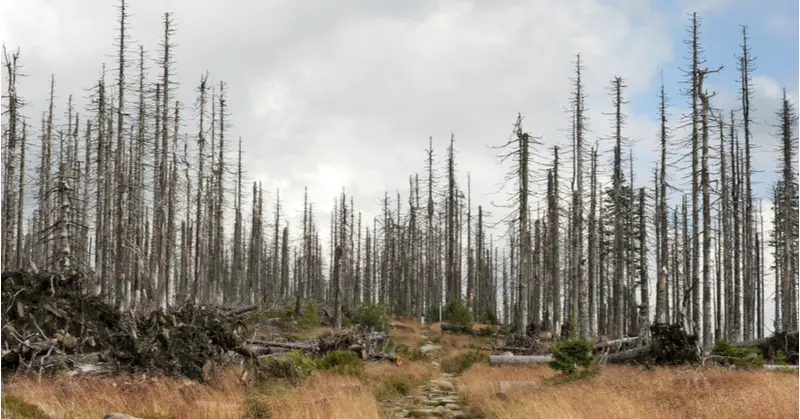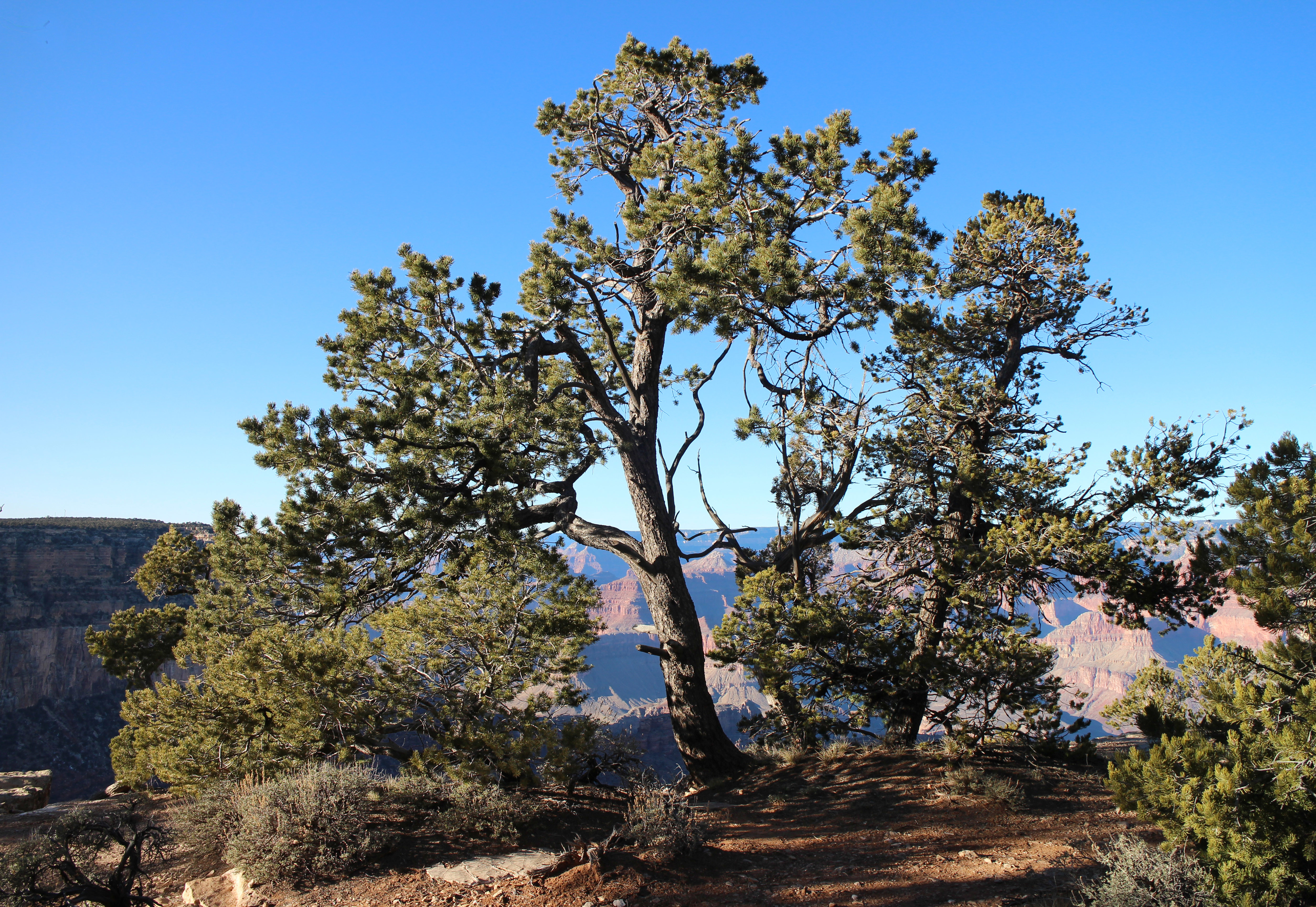
Forests are in the fight of the century. Covering almost 30% of the earth, forests provide a home to 80% of life on land, including plants, animals, and insects.1 Millions of acres of trees are lost to drought, heat stress, insect attacks, fires, and rising sea levels.
Often several of these factors work together to heighten climate change threats such as winter warming enhancing the ability of insect populations to survive the cold and attack trees in greater numbers. Or drought can make trees more susceptible to losing their leaves or increase their susceptibility to insects and disease.2
Prof. Matt Kirwan of the Virginia Institute of Marine Science studies ghost forests caused by sea-level rise along the U.S. Atlantic coast. A pattern of recurrent flooding and saltwater intrusion eventually kill adjacent forests. A TIME article quoted his comparison of ghost forests with receding glaciers when it comes to climate change, saying, “You can touch it and see it…It’s just as real as a melting glacier.” 3
In a review article about the role of sea-level driven land transformation in the creation of ghost forests, Dr. Kirwan and co-author Dr. Keryn Gedan from George Washington University observed, “Ghost forests and abandoned farmland are striking indicators of sea-level driven land conversion. Dead trees and stumps surrounded by marshland, for example, represent relic forestland that has been replaced by intertidal vegetation. Similarly, bare soil and wetland plants at the edges of agricultural fields indicate the encroachment of wetlands into formerly productive farmland.”4
In the video below, Dr. Kirwan shares an interesting trip to a ghost forest in Maryland’s Blackwater National Refuge.
In the western U.S., ponderosa pines and piñon pine forests are expected to die off with continuing increases in annual temperatures. Often overlooked is that droughts don’t just kill mature trees over time, they also kill seedlings that have more shallow roots and less water storing capacity than more mature trees.5 Without viable seedlings, recovery for the ecosystem as it was once known is not possible. We can’t leave out an interesting point about piñon pines: according to one Scientific American article, they can take anywhere between 75 to 200 years to reach maturity and some have been known to live to be 1,000 years old.6
A New York Times article documents that between 2012 and 2017, California’s longstanding drought killed an excess of 100 million trees. Between 2002 and 2003, over 350 million piñon pines died in Arizona, Colorado, Utah, and New Mexico that had covered 4,600 square miles.7 In the 2000s, beetle infestations were responsible for the loss of 150,000 square miles of lodgepole and ponderosa pine forests in the U.S. and Canada.7 Big Bend National Park in Texas lost almost 25% of its piñon pine trees from extreme drought in 2011. At that time, it was estimated at least 6% of trees across Texas died during that same drought event.8
It’s not just the trees that are lost. The animals that depend on them could face dire circumstances as well. The piñon tree is vital to a bird called the piñon jay. Here is how the Scientific American writer described the unique relationship: “The jay plucks seeds from the cones of piñon trees and stores them in great piles on the south side of the trees. Snowfall buries the seeds, hiding them in the winter, a stash only the jay, with its incredible memory, knows about. The bird feeds from these stores through the winter months. But many of the seeds sink into the soil or fall from the bird’s mouth, and the tree spreads quickly.”6
The news about climate change and forests isn’t all bad. For example, Drs. Kirwan and Gedan suggest that “the marshes and mangroves that replace inundated forests and farmland are considered among the most valuable ecosystems in the world because they improve water quality, reduce coastal erosion, protect against flooding, sequester carbon and support marine fisheries.” 4
That New York Times article offered a glimmer of optimism from a University of Arizona researcher, Dr. David Breshears, who told the reporter that “any reduction in warming will reduce tree die-off.” 7 We have to hope that as people unite in efforts to reduce climate change and nature finds a way to adapt to the changes that are happening, there will be some kind of balance that protects as much of our essential forest land as possible.
By R.A. Kroft
Sources
1Prolman Natalie. Forests Cover 30% of Earth, But Host 80% of Life on Land. Global Citizen. 3 March 2017.
2Anderegg WRL et al. Tree Mortality From Drought, Insects, and Their Interactions In a Changing Climate. New Phytologist. 2015;208: 674-683.
3Root, Tik. Ghost Forests Are Visceral Examples of the Advance of Climate Change. Time. 7 October 2019.
4Kirwan ML and Gedan KB. Sea-level driven land conversion and the formation of ghost forests. Nature Climate Change. 2019;9:450-457.
5Adams, Henry D. Temperature response surfaces for mortality risk of tree species with future drought. Environmental Research Letters. 2017;12(11): 115014.
6O’Donnell J. Should We Bid Farewell to Piñon? Scientific American. 10 October 2017.
7Robbins J. With Climate Change, Tree Die-Offs May Spread in the West. New York Times. 11 December 2017.
8Focus on Tree Mortality in a Warming World: Causes, Patterns, and Implications. Environmental Research Letters.
Video: Ghost Forest: Dying trees show climate change’s advance. Newsy/TIME. 8 October 2019.
—
R.A. Kroft writes about her day-to-day journey in living a smaller, more sustainable life and other topics that interest her.

This Site Was Inspired By An Interest in Protecting the Environment:
We had the privilege and joy of learning from Dr. Charlie Stine who instilled a love for the natural world through incredible field trips with the Johns Hopkins Odyssey Certificate program in Environmental Studies. At the time, the program was endorsed by the Maryland Department of Natural Resources. Sadly, after Dr. Stine retired, the program was phased out. We hope that we honor his legacy by shining a bright light on environmental issues and sharing good news about the success of various conservation programs when possible.
